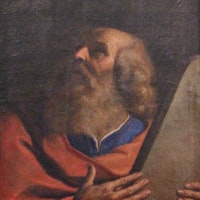So God created the human being in his own image, in the image of God he created him; male and female he created them.
Moses

In the Image of God
Topic: Divine Love & Goodness
So God created the human being in his own image, in the image of God he created him; male and female he created them.
Moses, a central figure in Judaism, Christianity, and Islam, is remembered as a prophet, lawgiver, and leader who shaped the history of the Israelites. Born in Egypt during a period of Hebrew enslavement in the 13th-14th century BCE, he narrowly escaped death as an infant under Pharaoh's decree to kill Hebrew male children. Rescued from the Nile by Pharaoh’s daughter, Moses was raised in the Egyptian royal household. As a young man, he fled Egypt after killing an overseer who was beating a Hebrew slave, an act reflecting his identification with his people’s suffering.
In Midian, Moses encountered God at the burning bush and was called to lead the Israelites out of bondage. Returning to Egypt, he confronted Pharaoh, and through the ten plagues secured their release. Moses then led the Israelites through the Red Sea in the Exodus, a defining moment in Jewish tradition. At Mount Sinai, he received the Ten Commandments, establishing a covenant between God and the Israelites and laying the ethical and spiritual foundation of Jewish identity. Over forty years in the wilderness, he guided his people, addressing their doubts and struggles as they journeyed toward the Promised Land.
Moses’s life ended on Mount Nebo, where he saw Canaan but did not enter it, dying at 120. Revered as Judaism’s greatest prophet, he is traditionally credited with delivering the Torah, though modern scholarship questions his direct authorship. His role as a mediator of Divine wisdom remains central to his legacy. For Christians, Moses foreshadows Christ as a lawgiver, while in Islam, he is honored as a key prophet and messenger. His life exemplifies leadership, faith, and enduring commitment to justice.
The Book of Genesis
Moses* Genesis 1.27. [Wilson, Andrew, editor. World Scripture - a Comparative Anthology of Sacred Texts. Paragon House, 1991] pp. 116, 193.

Moses
Theme: Divine Father and Mother

About This Passage From Moses* in Genesis [Commentary]
The Genesis passage offers insight into the inclusive and balanced nature of the Divine. The Hebrew term “adam,” signifying humanity as a whole, reminds us that the image of God is not confined to one gender but is fully expressed in both male and female. This shared origin affirms a universal human dignity, inviting us to see one another as complementary beings, unified in purpose and essence.
The idea of “dominion” in the passage highlights humanity’s shared responsibility to care for creation. Rather than a call to dominance, this dominion invites the integration of wisdom, compassion, and stewardship, drawing on both traditionally masculine and feminine attributes. This balance reflects the fullness of the Divine and underscores the importance of collaborative care for the Earth.
This narrative invites reflection on the Divine and our place within it, encouraging us to transcend societal constructs of gender and recognize a spiritual identity rooted in our shared likeness to God. By embodying qualities of the “Divine Father and Mother,” we can foster mutual respect and harmony, honoring the sacred in every person and nurturing a balanced relationship with each other and the world.
*Traditional attribution of Genesis 1:27 to Moses reflects the belief that he authored the Pentateuch. Modern biblical scholarship, however, suggests the text was compiled from multiple sources over time. Despite various academic perspectives, the Mosaic attribution holds significant weight in Jewish and Christian traditions, where Moses is considered the lawgiver and the one through whom God revealed the Torah. Even if Moses is not the author in a literal sense, he is often viewed as the figure through whom the Divine wisdom in these texts was mediated.
The Image of God in Man—Is Woman Included?
“Then God said, ‘Let us make humankind (adam) in our image, after our likeness; and let them have dominion….’ And God created humankind in his own image, in the image of God created he him; male and female created he them.” Gen 1:26-27 clarifies that the Hebrew term adam stands for the generic species of humanity which is composed of men and women. If there is any doubt in this interpretation, Gen 5:2-3 declares and defines again: “When God created humankind, he made him in the likeness of God. Male and female he created them, and he blessed them and named them humankind when they were created.” The “image of God in man and woman” opens us to transcend both the masculine and feminine metaphors for God which abound in the Bible and to transcend our historical selves and social institutions in recognition of the Holy One. It would appear that whatever one’s interpretation of the “image” and “likeness” of God, one would have to recognize that the biblical text makes explicit that in our resemblance to the Divinity and in our dominion over the earth and animals, men and women share a common human dignity.”
—Horowitz, Maryanne Cline. “The Image of God in Man—Is Woman Included?” Harvard Theological Review, vol. 72, no. 3-4, 1979, pp. 175–206.
In her article The Image of God in Man—Is Woman Included? Maryanne Cline Horowitz examines the Hebrew term “adam,” showing that it represents all of humanity—both male and female. She highlights how scriptural references affirm that the “image and likeness” of God encompasses both genders, reflecting the balanced nature of the “Divine Father and Mother.” Her work emphasizes that these Biblical texts provide a foundation for universal human dignity, inviting us to move beyond socially constructed roles and embrace the unconditional love inherent in the Divine.
Resources
Related Quotes
Copyright © 2017 – 2025 LuminaryQuotes.com About Us